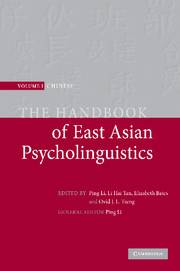Book contents
- Frontmatter
- Contents
- List of figures
- Notes on contributors
- Preface
- Introduction: new frontiers in Chinese psycholinguistics
- Part I Language acquisition
- Part II Language processing
- Part III Language and the brain
- 25 The relationship between language and cognition
- 26 Language processing in bilinguals as revealed by functional imaging: a contemporary synthesis
- 27 Specific language impairment in Chinese
- 28 Brain mapping of Chinese speech prosody
- 29 Modeling language acquisition and representation: connectionist networks
- 30 The manifestation of aphasia syndromes in Chinese
- 31 Naming of Chinese phonograms: from cognitive science to cognitive neuroscience
- 32 How the brain reads the Chinese language: recent neuroimaging findings
- Epilogue: a tribute to Elizabeth Bates
- References
- Name index
- Subject index
28 - Brain mapping of Chinese speech prosody
Published online by Cambridge University Press: 05 June 2012
- Frontmatter
- Contents
- List of figures
- Notes on contributors
- Preface
- Introduction: new frontiers in Chinese psycholinguistics
- Part I Language acquisition
- Part II Language processing
- Part III Language and the brain
- 25 The relationship between language and cognition
- 26 Language processing in bilinguals as revealed by functional imaging: a contemporary synthesis
- 27 Specific language impairment in Chinese
- 28 Brain mapping of Chinese speech prosody
- 29 Modeling language acquisition and representation: connectionist networks
- 30 The manifestation of aphasia syndromes in Chinese
- 31 Naming of Chinese phonograms: from cognitive science to cognitive neuroscience
- 32 How the brain reads the Chinese language: recent neuroimaging findings
- Epilogue: a tribute to Elizabeth Bates
- References
- Name index
- Subject index
Summary
Introduction
Speech prosody refers to melodic or suprasegmental features of an utterance (e.g. pitch) that may signal a variety of linguistic and paralinguistic functions (Lehiste, 1996). Over the last quarter century, increasing attention has been focused on the roles of the left (LH) and right (RH) cerebral hemispheres in the processing of prosodic information. Evidence has been steadily accumulating in the dichotic listening (Shipley-Brown et al., 1988), lesion deficit (Baum & Pell, 1999) and brain imaging (Meyer, Alter & Friederici, 2003; Plante, Creusere & Sabin, 2002) literature implicating the RH in the perception of prosodic units assigned to phrase- and sentence-level structures. Dichotic listening (Wang, Jongman & Sereno, 2001) and lesion deficit (Gandour, 1998a, b; Wong, 2002) data from tone languages point to LH and RH lateralization, respectively, for tonal and affective information. This chapter presents an overview of research findings from positron emission tomography (PET) and functional magnetic resonance imaging (fMRI) studies on the perception of Chinese speech prosody (see Buckner & Logan, 2001; Rugg, 1999, for tutorials on hemodynamic methods of brain imaging).
Background and significance
The underlying basis for hemispheric asymmetry of speech perception is controversial (see Ivry & Robertson, 1998; Poeppel, 2003; Zatorre & Belin, 2001; Zatorre, Belin & Penhune, 2002, for recent reviews). One view is that the LH is specialized for speech as opposed to other complex auditory signals.
- Type
- Chapter
- Information
- The Handbook of East Asian Psycholinguistics , pp. 308 - 319Publisher: Cambridge University PressPrint publication year: 2006
- 9
- Cited by



